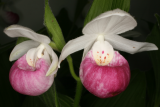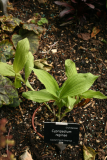Additional notes (click to expand)
Medicinal
Moermann notes that various Cypripediums from North America were used by the Cherokee, Iroquois, Chippewa, Algonquin, Okanagan-Colville tribes for Venereal disease, neuralgia, as an antihelminthic, for ‘fits’, colds, flu, stomach cramps, female troubles, male disorders, love potion, kidney trouble, diabetes, blood medicine, fever, sedative, soreness, ‘nervousness’ or lack of energy, TB, bites of a mad dog , to have small babies. He notes that the Menominee (from Wisconsin) used it as a hallucinogen.
Moerman, Daniel E. (2009) Native American Ethnobotany. Timber Press.
Toxicity
The glandular hairs on the leaves and stems can cause a rash, similar to "Poison Ivy" rash and some part of these plants may be mildly to severely toxic to either animals and/or humans.
Geographical distribution
- Northern America, Eastern Canada
- Northern America, North-Central U.S.A.
- Northern America, Northeastern U.S.A.
- Northern America, Southeastern U.S.A.
- Northern America, Western Canada
Cypripedium reginae Walter
Family: ORCHIDACEAEGenus: Cypripedium
Species: reginae Walter
Common names: Lady's Slipper Orchid
Distribution summary: Eastern North America
Habit: Perennial
Hardiness: H5 - Hardy; cold winter
Habitat: Bogs, swamps, prairies, wooded slopes on neutral to calcareous soils to 500m
Garden status: Not currently grown
Flowering months: May, June, July, August
Reason for growing: Medicinal, toxic


